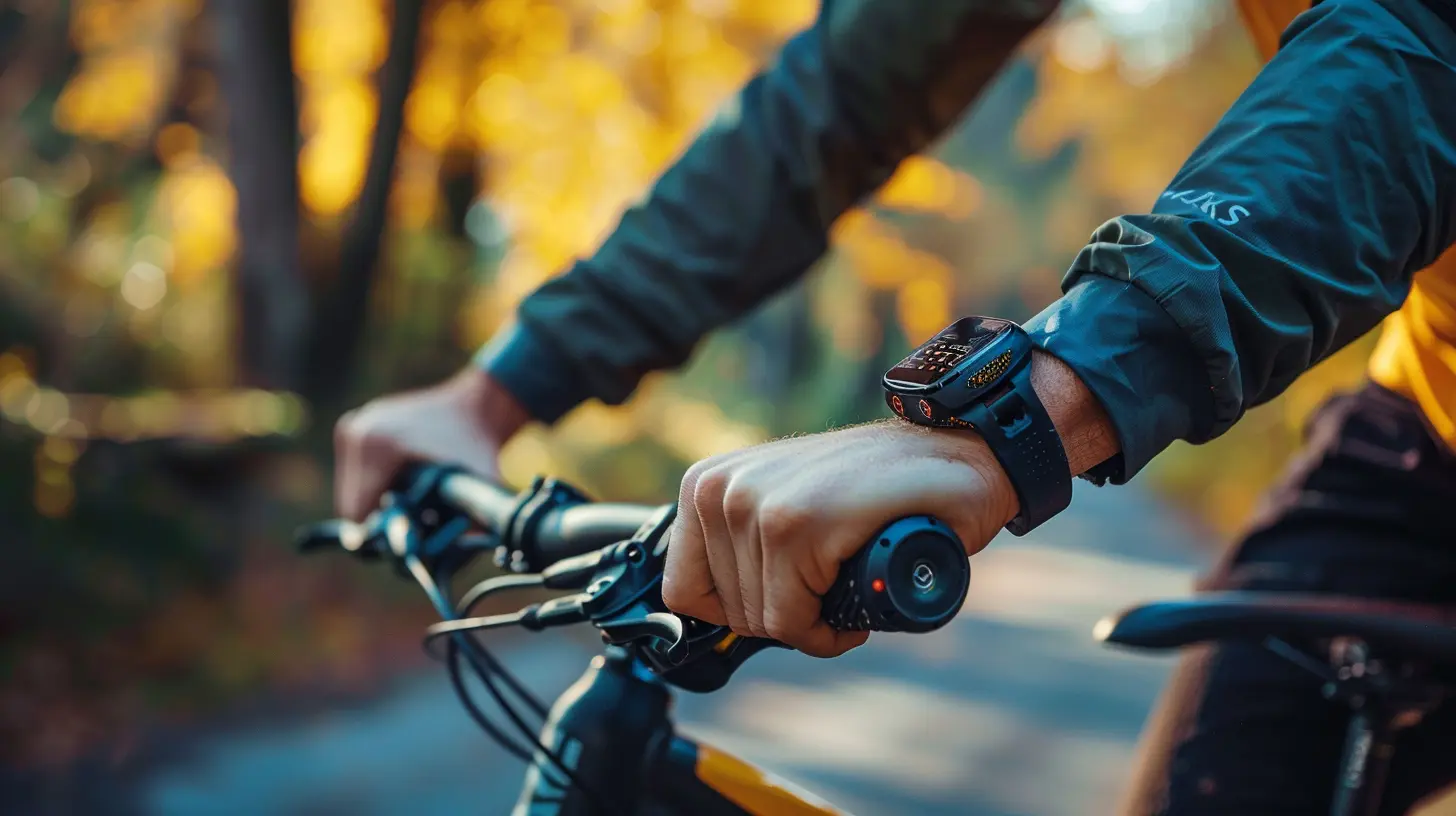How Wearables Are Making Cycling Safer and Smarter
11 November 2025
Cycling has long been one of the most enjoyable and eco-friendly ways to commute, exercise, or just explore the outdoors. But let's be honest—there's always been a level of risk involved. Whether it's avoiding accidents, tracking performance, or staying connected on the go, cyclists have had to rely on traditional methods to stay safe.
Enter wearable technology. These smart gadgets are revolutionizing the way cyclists ride, making things not only safer but also far more intelligent. From smart helmets that can call for help in an emergency to fitness trackers that optimize performance, wearables are changing the game.
So, how exactly are these devices making cycling safer and smarter? Let’s dive in. 
1. Smart Helmets: More Than Just Head Protection
Helmet technology has come a long way, and today’s smart helmets are packed with features that improve both safety and convenience.Built-in Crash Detection and SOS Alerts
One of the biggest concerns for cyclists is getting into an accident, especially when riding alone. Some smart helmets, like the Lumos Ultra or the Specialized ANGi, come equipped with crash detection sensors. If a sudden impact is detected, the helmet automatically sends an SOS alert with your location to a pre-set emergency contact.Integrated Lights and Turn Signals
Visibility is everything when cycling in low-light conditions. Many smart helmets now come with built-in LED lights and turn signals that can be controlled via a handlebar remote. This ensures that drivers and pedestrians always know your next move, reducing the risk of collisions.Bluetooth Connectivity for Hands-Free Communication
Ever needed to take a call or listen to navigation directions while riding? Many smart helmets now feature Bluetooth speakers and microphones, allowing cyclists to stay connected without taking their hands off the handlebars.
2. Smart Glasses: Augmented Reality for Cyclists
Smart glasses might sound like something straight out of a sci-fi movie, but they’re becoming a reality for cyclists everywhere.Real-Time Data Display
Instead of constantly looking down at a phone or cycling computer, smart glasses like the Everysight Raptor or Garmin Varia Vision project real-time data, including speed, distance, heart rate, and navigation, directly onto your field of vision.Rearview Cameras and Blind Spot Detection
Some smart glasses are integrated with rearview cameras, giving cyclists a live feed of what's happening behind them. This feature helps reduce the chances of getting caught off guard by approaching vehicles.Voice Commands and Smart Assistants
Got your hands full while cycling? Some smart glasses support voice commands, allowing you to control music, take calls, or get directions just by speaking—no need to stop and fumble with your phone.
3. Wearable Fitness Trackers and Smartwatches
Fitness trackers and smartwatches aren’t just for gym lovers—they’re an essential tool for cyclists who want to monitor their performance and gather real-time health data.Heart Rate and Performance Tracking
Tracking heart rate is crucial for cyclists trying to optimize their training. Devices like the Garmin Forerunner or Apple Watch provide real-time heart rate monitoring, helping riders adjust their intensity based on their fitness goals.VO2 Max and Recovery Insights
Some advanced wearables analyze VO2 max levels (a measure of cardiovascular fitness) and provide insights into recovery time. This helps cyclists avoid overtraining and maximize efficiency.GPS and Route Tracking
Want to discover new cycling routes or track your rides? Most smartwatches now come with built-in GPS, allowing cyclists to map their journeys with precision.
4. Smart Clothing: The Future of Cycling Gear
It’s not just helmets and glasses—wearable tech is making its way into cycling apparel, offering performance-enhancing and safety features.Smart Jerseys with Built-in Sensors
Smart jerseys from brands like Hexoskin contain biometric sensors that monitor heart rate, breathing rate, and calories burned. This data is sent to a smartphone app in real-time, helping cyclists adjust their effort accordingly.Haptic Feedback for Navigation
Ever wished you could get turn-by-turn navigation without staring at a screen? Some smart clothing, such as vibrating cycling gloves or jackets, utilize haptic feedback to guide riders through subtle vibrations, signaling when to turn left or right.Temperature-Regulating Fabric
Adaptive fabrics are being developed to help cyclists stay cool in the summer and warm in the winter. Some wearable tech garments even have built-in heating elements for those chilly morning rides.5. Smart Bike Sensors That Work with Wearables
Wearables alone can do a lot, but when combined with smart sensors attached to the bike, they become even more powerful.Tire Pressure Sensors to Prevent Blowouts
Low tire pressure is a common cause of accidents. Sensors like the Quarq TyreWiz provide real-time pressure readings and alert riders when adjustments are needed.Collision Detection and Proximity Alerts
Devices like the Garmin Varia Radar can detect approaching vehicles and send real-time alerts to a rider’s smartwatch or smart glasses, improving reaction time and safety.Cadence and Power Meters for Better Training
Cyclists aiming to improve their performance rely heavily on cadence and power meters, which sync with wearables to provide precise data on pedaling efficiency.6. The Role of AI and Machine Learning in Wearable Tech
Artificial intelligence (AI) is playing an increasingly significant role in cycling wearables. These technologies analyze data, predict potential risks, and provide actionable insights to riders.AI-Powered Injury Prevention
By analyzing a rider’s movement and posture, wearables equipped with AI can detect improper form and suggest corrections, helping prevent injuries.Smart Coaching with Personalized Training Plans
Many fitness wearables now come with AI-powered coaching, offering real-time feedback tailored to an individual’s fitness level and goals.Accident Prediction and Avoidance
Some wearables can detect unsafe riding patterns—such as sudden braking, swerving, or erratic movements—and issue alerts to help cyclists ride more safely.7. Privacy and Security Concerns with Wearables
Despite all the benefits, wearable tech comes with its share of concerns—especially when it comes to privacy and data security.Are Your Wearables Tracking Too Much?
Many smart devices collect extensive personal data, including location, heart rate, and behavioral patterns. It’s crucial to understand what data is being shared and how it’s being stored.Preventing Unauthorized Data Access
Wearable manufacturers continuously improve encryption and security, but users should take additional measures, such as enabling two-factor authentication and regularly updating device firmware.Balancing Convenience with Privacy
While these devices bring convenience, cyclists should be mindful of where and when they wear them, as some wearables continuously monitor surroundings and collect data even when idle.Final Thoughts
Wearable technology is transforming the world of cycling, making it safer, smarter, and more efficient. From smart helmets that call for help in an emergency to augmented reality glasses that display ride data in real-time, these innovations are enhancing how cyclists navigate the roads and trails.Whether you're a casual rider or a professional cyclist, investing in the right wearables can make all the difference. As technology continues to evolve, we can expect even more game-changing features to hit the market, making cycling safer and more enjoyable than ever before.
So, the next time you gear up for a ride, think about how wearable tech can help you pedal smarter and safer. Ride on!
all images in this post were generated using AI tools
Category:
Wearable TechAuthor:

Vincent Hubbard
Discussion
rate this article
1 comments
Rory Davis
Exciting advancements in wearables are revolutionizing cycling—making it safer and smarter for everyone! 🚴♂️💡
November 18, 2025 at 3:52 AM


